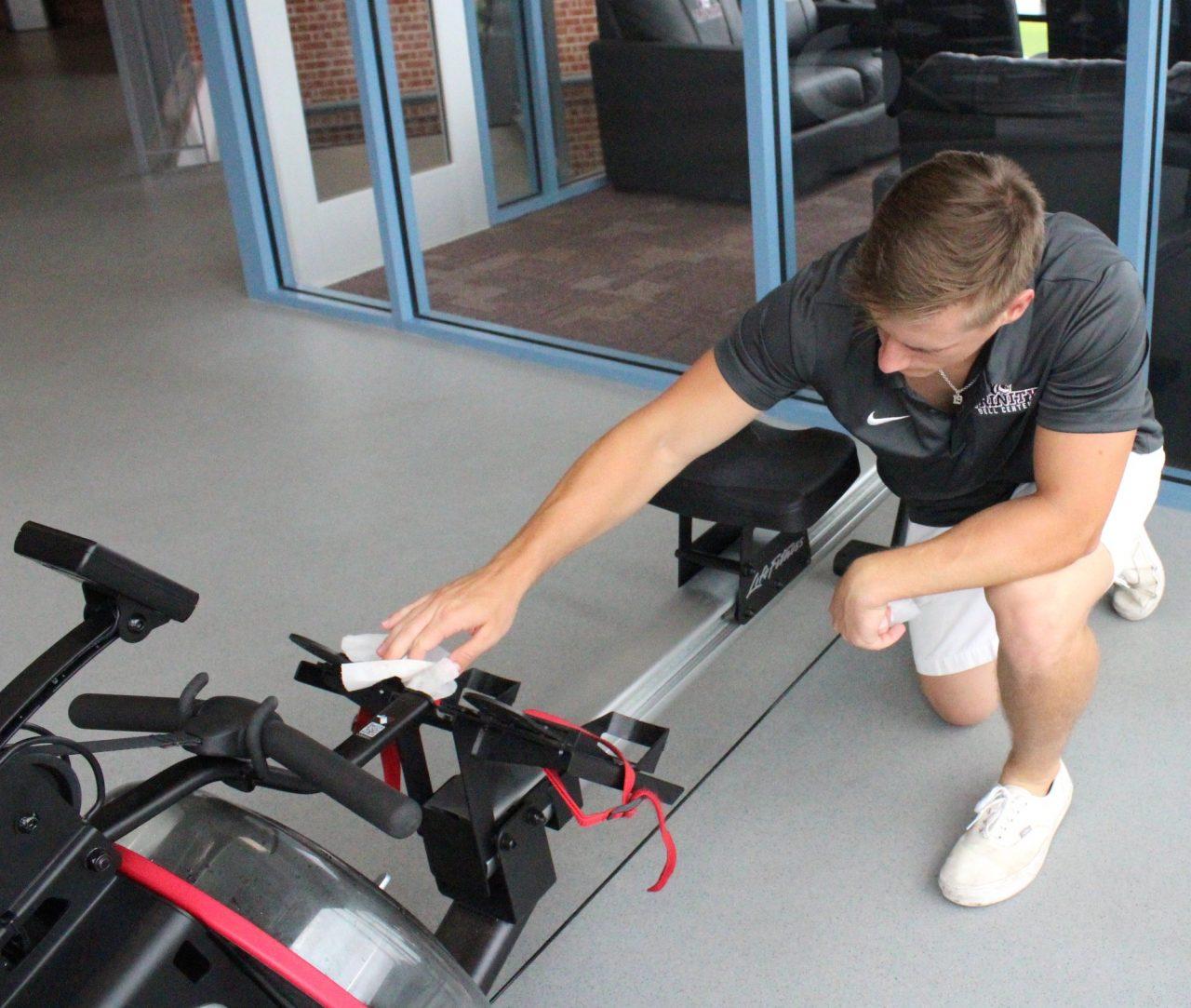This past fall semester I was kicked out of our student gym for wearing athletic attire that exposed my midriff. That night, I had gone to the gym intending to use the cardio room, but upon entering I was asked by a student employee to “cover up or leave” for “safety reasons.” The same employee informed me that five other women had already been kicked out of the gym just in August for violation of the dress code policy on midriff exposure. I was unsure of what threat my athletic wear posed to the safety of the gym. I had never been to a gym where wearing a crop top or a sports bra without a shirt is prohibited. In addition, midriff exposure was not prohibited by either fitness education instructor with whom I have taken yoga and weight training with in the Bell Center’s Stieren Dance Studio.
I wrote an inquiry to Dean Tuttle about the policy and my letter was forwarded to gym management. They responded stating that the dress code policy functions to protect students from Methicillin-resistant Staphylococcus aureus (MRSA). The Associate Director of Athletics for Facilities and Event Management, responded “… all users in the fitness center are asked to wear shirts to prevent direct skin contact (your midsection/back) with the equipment. Wearing a shirt over your sports bra is the easiest way to prevent potentially contracting a communicable skin disease … Communicable diseases like [MRSA] do spread in fitness centers.”
This explanation is scientifically unfounded. S. aureus, and other Staphylococcus species, are part of our skin’s normal bacterial flora, and are usually harmless in the absence of open wounds or compromised immune system. That being said, the skin of my midriff and chest do not pose a greater risk to public health than the skin of my hands, legs or arms, which are more in contact with gym equipment. If we must wear shirts so that our midriffs do not come into contact with gym equipment, then by that same logic we must also wear gloves to touch bike handles, pants to use the weight benches and long-sleeve shirts to use the mats. Additionally, the fabric of a t-shirt is permeable to bacteria, so a hazmat suit would be necessary to ensure protection from S. aureus. The Center for Disease Control (CDC) states on their website that there is a slightly increased risk of contracting MRSA from sharing exercise equipment, and the most effective preventative measure is to disinfect all equipment. Our gym policy already states that members must wipe down equipment after use, and I would assume that the gym also regularly disinfects all machines. Other recommended preventative measures are covering wounds, showering after exercise, and washing clothing and towels after exercise. I fail to see how evicting women from the gym is a better strategy for the prevention of communicable diseases than if gym management were to post signs that educate students about the warning signs of MRSA and advise appropriate preventative measures.
I surveyed my peers to find out if any of them, male or female, had a similar experience or witnessed people violating the policy. All the responses I received from students asked to cover up were female, and those seen violating the policy were overwhelmingly male. While the policy applies to everyone, regardless of sex, many of my peers believed it to be inconsistently implemented.
Three students shared their stories, and Trinity professors also weighed in on the topic:
“I was kicked out of the gym for showing less than half an inch of stomach,” said Tia-Rose Pezzani, former Trinity University student.
“… I was wearing extremely high-waisted leggings, and a sports bra that was not low cut … I was exposing maybe 3-4 inches of midriff … I got overheated during my workout and took off my t-shirt before getting on the bikes … an employee tapped me on the shoulder and told me to put my shirt back on or leave. I felt extremely embarrassed and ashamed just from being apprehended for showing more skin …” said Sophie Dwyer, junior communication major.
“I was told I couldn’t work out without a shirt covering me completely … proper gym etiquette would completely prevent [MRSA], not clothing measures,” said Lauren Bagg, senior communication major.
“While MRSA and other bacterial diseases can spread in gyms, cotton T-shirts would provide no protection from these bacteria. If the goal is preventing the spread of disease, a policy that requires wiping down gym equipment after each use would be far more effective than a wardrobe-based policy (unless biohazard suits were required). The policy appears to instead be a modesty policy, as the skin on an athlete’s hands, forearms, legs and face — which are freely exposed to gym equipment under the current policy — are no less susceptible to bacterial disease than the skin on their midriffs,” said Michele Johnson, Ph.D. associate professor of biology.
“To my knowledge, arms, hands and legs are no more resistant to bacterial infection than other parts of the body … As an institute of higher education, Trinity faculty and staff should strive to identify instances when biases and logical fallacies may have influenced health recommendations from government authorities. The apparent propensity for Trinity workers to implement the policy inconsistently for male and female students supports the argument that cultural norms regarding modesty, as opposed to science, may be driving this health policy recommendation … surely we can institute policies that make logical sense, do not violate what students learn in the classroom, and don’t set the stage for the selective shaming of female students,” said Carolyn Becker, Ph.D., professor of psychology.
Other professors who expressed their support include: Frank Healy, Ph.D., biology; James Shinkle, Ph.D., biology; Rosa Aloisi, Ph.D., political science; Rita Urquijo-Ruiz, Ph.D., modern languages and literatures; Norma Elia Cantu, Ph.D., humanities, modern languages and literatures.
I contacted other universities and stand-alone gyms in Texas to compare dress policy. The religiously affiliated schools, Southwestern University and St. Edward’s University, with the exception of the University of Texas San Antonio (UTSA), prohibited midriff exposure at their gyms. UTSA was forthright by stating that their policy was implemented for modesty reasons. Midriff exposure at UT Austin is not prohibited, but they ask that patrons put a towel on weight benches that they lay on without a shirt.
Anytime Fitness and L.A. Fitness have no policy against only wearing crop-tops or sports bras. Both gyms require close-toed shoes for safety, which is practical. As for covering the midriff, however, there is little evidence that it will prevent injury or the spread of communicable disease.
In the absence of a justifiable concern for health and safety, patrons should be able to wear any athletic clothing that is comfortable for them to workout in at the gym.







Sarah Jo'on Yeoung • May 12, 2019 at 11:52 am
Nobody wants to see your exposed beluga whale ass at the gym. Cover up like everyone else!